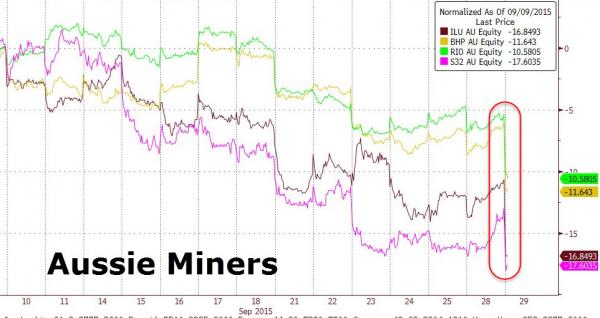It was a tale of two markets overnight: Asia first – where all commodity hell broke loose – and then Europe (and the US), where central banks did everything they could to stabilize the already terrible sentiment.
Asian markets were a bloodbath as we covered previously, with China’s Shanghai Composite sliding 2%, even as some big-cap marquee names plunged, but the one stock everyone was focusing on was Singapore-listed Noble Group (SGX:N21), which as we explained previously is Asia’s largest commodity trader and thus the continent’s “Glencore”, whose CDS blew out overnight, its 2020 bonds crashed to record lows and stock plunged as much as 15% before closing down 10% on Glencore – and commodity – counterparty risks and general liquidation concerns. This was broadly in line with the mauling of Australian miners which as we showed previously, also plunged overnight as the commodity liquidation ripple effects are starting to be felt virtually everywhere.

Another market that was not spared was Japan, whose Nikkei225, trading at nearly 21,000 just one month ago, crashed by over 4%, to close below 17,000 for the first time in 2015. In fact, despite persistent Japanese liquidity injections, the Nikkei has now wiped out all its gains for the year. Those Japanese pensioners must feel really good right now about selling “safe” JGBs and investing their retirement funds into risky assets which are now down for the year, even as the world’s biggest pension funds are now out of dry powder to push the Japanese stock market higher.
It wasn’t just China and Japan: tumbling resources stocks dragged Australia’s S&P ASX 200 to a two-year low. The benchmark fell 3.8%, its biggest one-day move in a little over a month.
The rout also lit a fuse under Asian currencies and commodities, which also plumbed fresh lows, with Malaysia’s ringgit falling as much as 1.2% against the U.S. dollar to yet another 17-year low while Indonesia’s rupiah touched 14,730 against the U.S. dollar, a fresh 17-year low. Industrial metals including zinc and copper fell to multiyear lows.
And then, just as all hope seemed lost, it was as if India’s RBI head Rajan heard our “plea” from yesterday evening…
…. and instead of cutting the Reserve Bank repurchase rate by 25 bps as everyone had expected, the RBI decided to ease that much more aggressively, and cut by 50 bps, as just 1 out of 52 economists survey by Bloomberg expected.
This announcement catalyzed a dramatic move in the all important USD/JPY, which after sliding to a low of 119.250 overnight just after the RBI surprise announcement, started its usual dramatic levitation to the 120 “tractor” point, and around 5am Eastern, the latest central bank intervention to stabilize the market selloff succeeded, with the key carry pair trading within a fraction of the magical support level that is so instrumental to keep stocks bid.
Despite opening lower across the board in reaction to lower close over on Wall Street and overnight in Asia, stocks in Europe also gradually edged higher (Euro Stoxx: -0.1%), as market participants used the recent selling pressure as an opportunity to reinstate longs. In particular, shares of the troubled trading and mining company Glencore (GLCNF) (+8.7%) surged higher, with analysts at Citi noting that the recent price action is somewhat exaggerated and that the company should go private if fall in share price continues.
In terms of fixed income, the release of lower German state CPIs failed to support Bunds and instead the price action was dominated by stocks-specific recovery in sentiment, with the US and German benchmarks both heading into the North American crossover relatively flat.
End result: after sliding first thing in overnight trade, both European stocks and US equity futures are now trading near their highs, with the E-mini last seen around 0.5% higher on the session, even pushing up Volkswagen (VLKAY) stock, which was deep in the red earlier, to virtually unchanged on the session, while suddenly all-important Glencore, was up 5% at last check even as its CDS keep soaring to new all time highs.














Leave A Comment